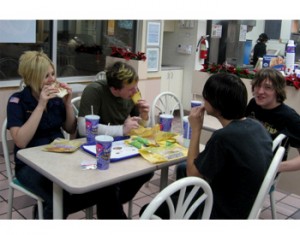 With a potential for 300 calories or more coming from your child’s sugary drink, it’s no wonder studies are being undertaken to find ways to decrease this type of beverage intake in adolescent populations.
With a potential for 300 calories or more coming from your child’s sugary drink, it’s no wonder studies are being undertaken to find ways to decrease this type of beverage intake in adolescent populations.
Yet decreasing the amount of calories adolescents drink on a daily basis doesn’t have to be that difficult. Simply letting kids know what those calories mean may be all it takes.
Researchers from Johns Hopkins Bloomberg School of Public Health recently reported in the American Journal of Public Health that providing African American adolescents with the facts about some of their favorite high-calorie drinks dramatically reduced how much they drank by 40%. Even better, letting the kids know how much physical activity it would take to burn off one drink resulted in a 50% decrease in high-calorie beverage consumption.
Apparently, adolescents, just like adults, want to better visualize what’s in their food. By showing the impact calories play on our daily lives, its much easier to see why getting just the right amount is important.
Yet you don’t have to wait for this type of information to be displayed in your local convenient store to help your child understand the impact of good nutrition. Instead, you can start empowering them with this information now so that they can start making good food decisions today instead of tomorrow.
Although starting a conversation about nutrition with your adolescent can seem difficult or even awkward, it often just takes a little practice and know-how. To help get you started, here are a few healthy eating conversation tips:
Talk about the consequences.
Don’t be afraid to discuss how what you eat impacts what you do. If you know how many minutes or hours it would take to burn off the calories in a treat or beverage, share that information with your child. It can help them better visualize the amount of calories they could be consuming. If you aren’t sure how many hours of running or dancing it takes to burn off the calories in your child’s favorite snack, that’s okay too. Focus on what you do know and be honest about your level of nutrition knowledge. If you don’t know a lot, that’s perfectly fine and perhaps you and your child can set a goal to learn more together.
Use real-life examples.
Whether you are in the grocery store or sitting at the dining room table, food is close in either situation. Use those opportunities to discuss with your child what you are eating, what the benefits are, and what that food helps you do. If you aren’t sure, get some back up! Set up a meeting with a registered dietitian or find one online. They can help you get that conversation going.
Make calorie-free beverages available.
Although talk is good, reinforcement through action is even better. Keep healthy options around so your child has healthy options to pick from. When it comes to beverages, think bottled water. You can even get creative by adding splashes of 100% fruit juice to each bottle or try mixing in frozen berries or citrus fruits to keep the flavor interesting.
Teaching your child or teen about nutrition can help them not only make good decisions today, but for a lifetime. Help set them up for a lifetime of good nutrition by beginning the conversation today.
